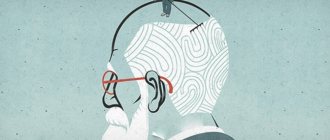06/16/20215 minutes read 535
The foundations of psychoanalysis were formed at the turn of the 19th and 20th centuries. Today, although the concept remains controversial, it has become an important and integral part of modern culture, having a significant influence on philosophy, medicine, religion and culture. Any educated and inquisitive person should have an idea of what psychoanalysis is and understand its basic terms.
The founder of psychoanalytic theory is the Austrian physician Sigmund Freud (1856 - 1939). He was educated at the University of Vienna, did an internship in France, in Berlin, and then went into private practice, working with patients of various ages, trying to find effective ways to treat neuroses, mental disorders and explain their causes.
Long-term and professional continuous practice pushed him to form his own concept, which he repeatedly outlined in his numerous works, talking about what the unconscious is, what role it plays in human life and how to use this knowledge in practical activities in various fields of knowledge.
Initially, S. Freud started from the concept of “catharsis,” which goes back to Aristotle. The essence of the term is that during the emotions that a person experiences, perceiving works of dramatic art, empathizing with the characters, the soul is “cleansed” of everything accumulated over many years.
Therapy based on this concept involved using hypnosis to force a person to remember the emotions they experienced during a traumatic event. This procedure brought relief. But one day Freud came to the conclusion that not all patients are amenable to hypnosis, and this prompted him to search for new techniques of influence. Thus, a method based on free associations soon appeared.
Patients were asked to talk about all the associations and fantasies they had in the process of discussing any issues or interpreting dreams. This made it possible to build hypotheses regarding the origins of the disease. Thus psychoanalytic theory was born.
Quote According to Freud, of all the discoveries that humanity has ever made, three can be identified that have caused significant damage to human narcissism:
1. The cosmological theory of Nicolaus Copernicus, which proved that our planet is not the center of the Universe, but is just one of the planets of a small system. 2. The biological concept of Charles Darwin, according to which man is not a higher power, but is descended from animals as a result of natural selection common to all living beings. 3. Freud's own discovery of the unconscious and its superiority over consciousness.
What is psychoanalysis
Psychoanalysis is a theory founded by Sigmund Freud, as well as a method for eliminating psychological problems.
When developing the theory, the famous Austrian psychotherapist used many years of experience gained during his medical practice.
So, what do the basic principles of psychoanalysis say?:
- Conflicts between the conscious and unconscious can lead to neuroses, fears, depression and other mental disorders.
- A person’s experience, knowledge and behavior are formed on the basis of his irrational unconscious drives.
- An individual trying to realize these drives “turns on” defense mechanisms that interfere with the process of awareness.
- The influence of the unconscious can be neutralized through its awareness. Psychoanalysis is a therapy that involves solving a problem.
The key idea of psychoanalysis comes down to the statement that a person is not aware of his own motives for behavior - they need interpretation. According to Freud's classical psychoanalysis, the patient should voice all his thoughts, associations, and dreams. The task of a psychoanalyst is to analyze what he hears.
Sources
- Tenyi T. . // Psychiatr Hung - 2021 - Vol36 - N2 - p.225-227; PMID:33870909
- Dembińska E., Rutkowski K. The reception of Dr Ludwik Jekels' “apostolic activity” to promote psychoanalysis in Poland before the outbreak of World War I. Part 2. // Psychiatr Pol - 2021 - Vol54 - N6 - p.1231-1254 ; PMID:33740807
- Dembińska E., Rutkowski K. The reception of Dr Ludwik Jekels' “apostolic activity” to promote psychoanalysis in Poland before the outbreak of World War I. Part 1. // Psychiatr Pol - 2021 - Vol54 - N6 - p.1209-1230 ; PMID:33740806
- Botbol M. Psychoanalysis and Psychodynamic Psychiatry in France. // Psychodyn Psychiatry - 2021 - Vol49 - N1 - p.19-23; PMID:33635105
- LaMothe R. Psychoanalysis and the Ungovernable Self: Further Explorations. // Psychoanal Rev - 2021 - Vol108 - N1 - p.27-50; PMID:33617335
- Miller IS. BALANCING THE GENERAL WITH THE PARTICULAR IN PSYCHOANALYSIS. // Am J Psychoanal - 2021 - Vol81 - N1 - p.1-5; PMID:33597722
- Holmes J. Friston's free energy principle: new life for psychoanalysis? // BJPsych Bull - 2021 - Vol - NNULL - p.1-4; PMID:33597069
- Ruberg W. Infanticide and the influence of psychoanalysis on Dutch forensic psychiatry in the mid-Twentieth century. // Hist Psychiatry - 2021 - Vol - NNULL - p.957154X21989174; PMID:33569987
- Schröter M. . // Nervenarzt - 2021 - Vol - NNULL - p.; PMID:33512564
History of psychoanalysis
The history of psychoanalysis dates back to 1880, in the days when the Viennese physician J. Breuer shared with his comrade S. Freud a remarkable story about a patient who was cured of the symptoms of hysteria after a hypnosis session. At the reception, she was able to voice a deeply traumatic event that happened to her. The result was a strong emotional reaction. Catharsis resulted in a significant reduction in symptoms. When the patient emerged from the hypnosis state, she had no memory of her confessions.
Freud decided to apply the technique with his patients - Breuer's results were confirmed. The partners shared their findings in a joint publication, Research on Hysteria, arguing that the symptoms of hysteria are caused by repressed memories of traumatic events. The difficult situation is repressed from consciousness, but continues to influence the patient.
Personal reasons prompted Breuer to withdraw from research and Freud began independent work. He was able to discover that a similar result is achieved not only with hysteria, but also with obsessive states of a sexual nature, often arising in childhood.
The psychoanalyst initially considered the Oedipus complex to be the key cause of neuroses. The symptom begins to form at moments when the child’s unconscious drives threaten to break through the barrier set by repression, which turns out to be unacceptable for other parts of the psyche due to fear of punishment and for moral reasons.
On the origin of neuroses and depression
Upbringing
represents a series of inevitable traumas for the child.
At the same time, the child is traumatized by the most significant people for him, whom he loves and who are authorities for him - these are parents, educators, teachers. To save his love for them and their authority, the child forgets about his traumas (see repression
).
And these difficult feelings associated with these traumas continue to exist in our unconscious, gradually poisoning our lives (see Survive in order to forget
).
Just as a leg broken in childhood can then hurt throughout life and cause lameness, childhood injuries also cause a series of chronic failures in life, neurosis and depression, but the cause of mental pain has already been forgotten.
Basics of psychoanalysis
Psychoanalysis is a therapy based on several immutable principles:
- First of all, the principle of determinism is implied. According to the ideas of psychoanalysis, not a single manifestation of the psyche can be called random, unrelated to anything, or involuntary. Conscious feelings, thoughts, impulses should be considered as events of cause-and-effect interactions determined by early childhood experience. Special research methods (mainly through dream analysis and associations) reveal the connection between situations from the past and current psychological experience.
- The basis of the second principle was the topographical approach. All mental elements are assessed according to the criteria of their accessibility. Repression, which ensures the removal of certain psychological elements from consciousness, indicates that a certain part of the psyche is making efforts without wanting to realize them.
- The third dynamic principle is based on the theory that the psyche is driven to action by impulses of aggression and sexuality, which are elements of a common biological heritage. They have significant differences from the instinctive behavior of animals. In the animal world, a stereotypical response is usually recorded, provoked by special stimuli in certain situations and aimed at survival. Psychoanalysis considers attraction as a state of nervous excitement, which is a response to stimuli that direct the psyche to action and relieve tension.
- The fourth principle is the genetic approach. The personality traits of an adult, characterizing his conflicts and neurotic symptoms, are generally associated with the fantasies and desires of childhood. It is believed that no matter what paths open to a person, he will not be able to escape from his own childhood experiences - in any case, they will haunt him throughout his life.
Methods of psychoanalysis
Let us consider in detail the main methods used in the field of psychoanalysis: the method of dream interpretation, the method of free association, the method of interpretation. Let's describe each one separately.
Free association method
What is this famous method based on? On the use of the phenomenon of associative thinking in order to study deep mental phenomena and processes (often they are unconscious). The data obtained are used for the treatment and correction of functional mental disorders, with the help of the patient’s awareness of the nature and source of the problems.
What is special about the free association method? In a conscious joint and purposeful confrontation between the therapist and the patient with a state of psychological discomfort. Acting together, the psychoanalyst and the patient cope with the problem.
The method of free association can be called a method for studying the mental state of a patient. He talks about any thoughts that come into his head, no matter how absurd or inappropriate they may seem. They may sound fantastic, ordinary, obscene. The therapist has to draw a conclusion from these revelations or incoherent fragments of thoughts.
In the “Dictionary of Psychoanalysis” (J.B. Pontalis, J. Laplanche) it is noted that free associations can be called the expression of all indiscriminately ideas and thoughts that arise in the mind - spontaneously or starting from any element (number, word, image from a dream).
Freud called for abandoning the role of controlled consciousness, beginning to understand mental processes. He stated that consciousness tries to eliminate images and thoughts that appear on the periphery before the attention of the analyzing object is focused on them. Moreover, when analyzing the mental state, it is these images and thoughts that can carry special meaning.
It was Freud who first began to actively use the method of free association. The psychoanalyst suggested that his patients lie down on the couch and relax, simply saying whatever came to their mind, no matter how incredible, absurd and unusual these thoughts were from the point of view of usual moral standards. During the sessions, the therapist observed how powerful emotional drives led uncontrolled thinking to mental conflict. The famous psychotherapist stated that the first random image and thought implies exactly what is needed for psychoanalysis. A random thought may have a connection to a repressed memory.
Dream interpretation method
According to the theories of Sigmund Freud, dreams can reveal the presence of intense mental activity in the depths of consciousness. What is dream analysis? The therapist must find the distorted unconscious truth hidden in every dream. Freud was convinced: the stranger and more confusing the dream, the more hidden content it contains. In the language of psychoanalysis, this phenomenon is called resistance - its manifestations can be noticed even when the person who saw the dream does not agree to its interpretation. This speaks of his unconscious resistance, established barriers to protect his own psyche.
Dreams separate the unconscious from the real world. In them, exciting situations that cause emotions are deformed in the most bizarre way. Dreams can also tell about secret desires. In the case of child psychoanalysis, the differences between hidden and overt thoughts are less clear.
Hidden thoughts are transformed into symbols, appearing in a form acceptable to consciousness. This allows them to bypass certain "censorship". Even today, the manifestation of the unconscious in the form of dreams remains one of the greatest mysteries of consciousness.
The method of dream interpretation is very important - it allows you to identify the essence of the images that appear in a dream. Freud processed dreams by positioning them as symptoms of illness. According to him, for the correct use of this method, it is not recommended to consider dreams as something single - such an analysis will not lead to anything worthwhile. He was convinced: when analyzing dreams, it is necessary to painstakingly study its elements separately. The association rule should be applied to individual fragments. Freud considered any dream not only an object worthy of scientific research, but also a way to know one’s deep essence, to discover hidden desires that do not appear on the surface.
Interpretation method
Interpretation is considered one of the most important tools of any analyst. Even in the interpretation of dreams and free associations, interpretations are used by the therapist. What does this term mean?
Interpretation is called the main analytical tool. In dream interpretation and free association, the psychoanalyst attempts to use interpretations. We are talking about transferring significant information about the patient from the unconscious level to the conscious level. Repressing information that causes concern and anxiety in an individual, as well as its correct analysis, will soften the symptoms of neurosis or other mental problems.
Family psychoanalytic therapy
Psychoanalysis as a method of psychotherapy has always been personal, one on one with the therapist.
But specialists need to work not only with the client, but also with the family. Group work is more complex and difficult and requires serious training of the psychotherapist. What approaches to solving family problems do psychoanalysis and psychoanalytic therapy provide?
Family psychoanalytic psychopathology is a branch of psychology that studies problems in family interpersonal relationships. It is generally accepted that family difficulties are difficult, disharmonious, pathological or abnormal relationships in the family, which were provoked by dissatisfaction with the basic needs of one of its members. The main signs of this situation can be considered dissatisfaction with family life, difficulties in communication, conflict, reluctance to engage in dialogue, dissatisfaction with marriage.
To solve such a problem, additional efforts are required on the part of each member and the entire group on the path to achieving harmony and mutual understanding, the formation of maturity and normal life and functioning. Difficulties in relationships can be caused by the following problems:
1. Lack of the required level of psychophysical compatibility
. This may be an imbalance in sexual life and communication, which is provoked by a negative perception and awareness of the physical attractiveness and spiritual acceptability of the spouses to each other. The problem is manifested by such phenomena as emotional and physical discomfort, tension in communication, mismatch of internal and also external efforts of both parties.
2. Lack of personal maturity
. Moreover, this factor may concern children, parents, or apply only to spouses (adult family members). Difficulty is formed under the influence of the following circumstances: age, gender, role place of a family member. We can talk about the presence of a problem if one or several of these factors are present: neuroses, behavioral difficulties, mental stress, insufficient adequacy in reactions to certain situations, difficulties in controlling behavior, feelings, emotions.
3. Lack of aspiration or insufficient strength on the way to satisfying basic needs in tandem children-parents, spouse
. An indicator such as a weak degree of satisfaction with the individual physiological and psychological traits and characteristics of one family member, weak assistance in the desired level of development of relationships between participants and the family as a whole can indicate this problem.
4. Disagreement and lack of common views
in the understanding and perception of certain issues and values among children, parents, and spouses. The problem is manifested by non-perception of another family member as a full-fledged person, different views on the perception of oneself and other family members, an insufficient level of communication and taking into account other people's opinions.
5. The predominance of negative, contradictory feelings over positive emotions in family relationships and communication. This difficulty manifests itself in the form of anger, hatred or indifference, boredom and disgust, anger and disappointment, indecision and apathy on the part of one or several family members.
6. Increased conflict and competition within the family
. Reluctance to find compromises, the desire to always dominate in all matters, the lack of desire to adapt to other family members are the main reasons for the formation of difficulties. The problem is manifested by the impossibility of a calm distribution of responsibilities in the family, the constant struggle for leadership, insufficient participation in family affairs, the presence of different models of communication in the family, insincerity and secrecy, and insufficient expression of will.
7. Difficulties in finding a single correct solution to a specific issue in one of the life cycles of the family. One of the reasons can cause such consequences: isolation and closedness of the participants during the discussion, reluctance to solve family problems, frequent doubts about the implementation of specific solutions.
Techniques and techniques known in family psychotherapy
Analytical techniques
Analytical techniques of family psychotherapy include procedures such as dream analysis, identifying free associations and fantasies, identifying individual and family resistance, and studying the current experiences of family group members. For these purposes, confrontation, clarification, and elaboration are used.
Special techniques
Special techniques known in family psychotherapy involve fighting inappropriate, inadequate denial, transferring a hidden subconscious conflict into an explicit open form of interaction, neutralizing the form of communication with the “scapegoat” participant, weakening the degree of conflict, getting rid of feelings of guilt (fear).
Specific non-analytical techniques
Specific non-analytical techniques involve observing patients, listening to their points of view, abrupt stops of speech in case of “empty judgment” and “deadlock in the dialogue”, partial intervention in the conversation, temporary removal of one or more participants from the process, comparison of positions, acceptance of opinions and understanding each participant.
Family psychoanalytic psychopathology is a branch of psychology that studies problems in family interpersonal relationships
Stages of family psychotherapy
1. Psychodiagnostic stage. At this stage, it is important for the specialist to establish non-verbal and verbal contact with the family, get to know its members and the family’s way of life.
2. Stage of awareness. In-depth study of interpersonal, psychological, personal, general family problems. This is done in order to achieve emotional awareness of the difficulty, the reasons for its development, and personal attitudes to the issue are taken into account and the situation is assessed by another member of the family group.
3. Reconstructive stage. It involves coordination of relationships between all family members. This is done in order to achieve compatibility in the relationship.
4. Adaptation stage. At this stage, it is important to adapt to the new level of psychological maturity obtained during therapy, to form motivation and attitudes for overcoming difficulties independently.
Based on materials from an article by A.N. Kharitonov in the journal “Psychoanalytic Bulletin”, No. 10, 2002.
Psychoanalysis in psychology and philosophy
One can hear many general statements about psychoanalysis. It is usually noted that psychoanalysis is a well-known direction in psychology, the benefits and significance of which are assessed differently. The method has both supporters and opponents.
If we talk about psychoanalysis in a philosophical vein, it is noted that a feature of psychoanalytic concepts is their connection with psychotherapeutic practice. It is not reduced to either experimental knowledge or philosophical speculation, but grows from the experience of communication and other aspects. Real comprehension of your inner world is achieved through insight. Such insight brings changes to the patient’s life - he begins to think about himself and his beliefs in a completely different way.
This philosophy is somewhat similar to ancient teachings that combined the theory and practice of Zen Buddhism, yoga and other types of mental self-regulation.
The practice of psychoanalysis is periodically compared with the healing actions of priests and shamans. Training in psychoanalysis is equated to initiation. It is no coincidence that many famous analysts who practice psychoanalysis simultaneously show interest in various Eastern teachings and even magic.
Most adherents of Freud's theories, as before, adhere to the model of the human psyche that was supported by the “father of psychoanalysis.” Their beliefs are based on the fact that psychoanalysts usually receive psychological or medical training. Their task is to adapt the patient to surrounding circumstances. To a large extent, psychoanalysis is widespread in America and the most developed European countries.
At one time, Sigmund Freud still hoped that his theories of psychoanalysis would be recognized by the scientific community. For this purpose, he resorted to analogies with archeology, hydraulics, economics and other sciences. Gradually, the conviction began to grow stronger in him that this would not happen after all.
The first reason can be called the difference in approaches, and the second is that for scientists, whose formation took place in the scientific fields of the nineteenth century, psychoanalysis is an unacceptable aspect for personal reasons. The ideas of therapy ran counter to narcissistic illusions about the power of the mind over nature and oneself. In general, the frequency with which many representatives of science and philosophy condemned the principles of psychoanalysis indicates their obvious bias. Gradually these beliefs began to change.
Today, the scientific status of psychoanalysis periodically continues to be challenged. Some researchers are inclined to think that it is still scientific, others question this statement, calling the well-known therapy pseudoscience.
However, in the twentieth century, psychoanalysis became widespread in the humanities, psychology, philosophy and other fields.
Freud's theory of psychoanalysis: briefly
According to Freud's theory, the human psyche can be “divided” into the following components: Ego, Id and Superego.
Definition of terms:
- The id is the main source of drive and desire. As an analogy, we can cite an ordinary street dog, where all its actions, such as mating, sleeping, etc., are the result of instincts inherent in nature.
- The ego is a mediator that divides social frameworks and animal instincts. The part of the personality that satisfies the needs of the id, taking into account the limitations of the external world.
- The superego implies all social frameworks, starting with the period of parental education, when the foundations are laid for what can be done and what is unacceptable. In adult life, it is reflected in all aspects of life, such as morality, religion, law.
The topical model of the mental apparatus includes two elements: the unconscious and the conscious.
What do they mean:
- The unconscious is psychic forces that are below the level of consciousness. They determine how a person behaves.
- Conscious is a mental aspect that an individual is able to become aware of. Consciousness has a direct impact on how an individual positions himself in society. The psyche can automatically be corrected by the pleasure principle. If the balance is disturbed, then a reset occurs through the unconscious sphere.
Defense mechanisms realize the conflict between the Superego and the Id. Freud described many of them: isolation, projection, repression, denial, substitution, regression and so on.
Classic psychoanalysis by Sigmund Freud
Having begun to develop a new approach to the treatment of mental problems, Freud initiated his own research and studied the data of other scientists. Nowadays the theory of psychoanalysis is considered truly unique. What distinguishes her from others is that she does not undertake to study individual problems of an individual. Psychoanalysis looks at everything in its entirety. We suggest that you briefly familiarize yourself with the main provisions of therapy.
Classical psychoanalysis is based on the determinism of the biological component - on the assertion that physiological needs suppress all others and indicate their vector. Mental determinism indicates that any incident in a person’s life has its consequences. Each of his actions is determined by an obvious or hidden motive, which was preceded by certain events.
Several aspects of an individual’s mental life are distinguished: conscious, preconscious, unconscious. In the first case, we are talking about experiences and current thoughts, in the second – about secret desires and fantasies, in the third – about what stands out from consciousness, suppressed by the internal censor. Freud believed that psychology should be interested in this complex mechanism in detail.
Followers of Freud.
After the First World War, psychoanalysis not only revolutionized the entire psychiatry and psychotherapy, but also introduced a lot of new things into the study of man and his motivational sphere. Psychoanalytic concepts such as “Freudian slips,” “rationalization,” “sublimation,” “repression,” “ambivalence,” and “substitution” have even entered everyday language (see also PSYCHOLOGY).
Some of Freud's early students, most notably Carl Jung (1875–1961) and Alfred Adler (1870–1937), used psychoanalysis as a starting point for developing their own psychological concepts. Jung interpreted the nature of drives in many ways differently than Freud. In addition to the personal conflicts of the individual, culturally determined and unconsciously transmitted symbolic representations of the main “themes” of human existence are important. According to his concept, at the center of individual experience are constantly emerging mythological themes common to all humanity. At the heart of all struggling tendencies in a person’s life are archetypal (primary) images that conflict with each other. Jung's idea of transmitting unconscious fantasies through the collective unconscious seemed purely theoretical and even mystical to Freud and his followers (see JUNG, CARL GUSTAV).
Alfred Adler believed that Freudian psychoanalysis underestimates the role of social factors, emphasizing the primacy of sexual desires. He associated the causes of individual conflicts with more superficial factors, especially feelings of inferiority and a sense of uncertainty about one’s social status, physical abilities, or sexual capabilities. Many of Adler’s ideas contributed to the further development of the concepts of self-esteem and especially to the analysis of its violations in the so-called. narcissistic personality disorders (see ADLER, ALFRED).
Otto Rank (1884–1939) was amazed by the discoveries that were made during research on the negative consequences of separation of a child from his mother. He developed Freud's hypothesis about birth trauma as a prototype of an anxious situation and proposed a system of psychotherapy based on overcoming separation trauma. Rank considered the will to be the decisive factor in the relationship between patient and psychoanalyst, and his system of psychotherapy is known as will therapy (see RANK, OTTO).
Psychoanalysis of modern times
Sigmund Freud was convinced that all our actions are dictated by subconscious desires. Particular emphasis was placed on the fact that emerging needs are based on physiology and sexual desires. Modern psychology no longer focuses on this and does not pay too much attention to the statement.
How widespread is psychoanalysis today? In many countries it is quite developed, being quite an ordinary phenomenon. Many modern therapists write books on this topic, which are very popular - that is, it is in demand. Of course, a certain type of society has long resisted the principles of psychoanalysis, not accepting them. This can be said about Germany during the period of National Socialism and the USSR before the Brezhnev stagnation. These examples are the most obvious. Both the fascist and communist regimes opposed Freud's teachings on ideological grounds. The Germans considered these theories “Jewish science that degrades human dignity,” and the Soviet Union considered these theories “the apotheosis of bourgeois individualism.”
Both hidden attempts to oust the teaching from the life of society and obvious repressions against it are known. It is worth recognizing that psychoanalysis also runs counter to many religion-centered and theocratic societies. Although there are cases when it was successfully developed in countries with authoritarian political regimes. The most obvious example is Argentina. According to the assumption of the Argentine psychotherapist A. Benjamin, the reason is that it was the psychologist’s office that usually became the last refuge for oppressed citizens, where freedom of speech was not prohibited.
To summarize, the conclusion suggests itself that freedom is considered the main condition for the successful development of psychoanalysis in society. Let us clarify that in this case, society should share the value of freedom, it should demonstrate the real implementation of freedoms (personality, speech, thought). By the way, for the full development of psychoanalysis, freedom of association is required, which makes it possible for the corresponding community to take shape.
In general, psychoanalysis is quite common in modern society. Various trainings are conducted, therapeutic rooms operate, and relevant literature is published.










